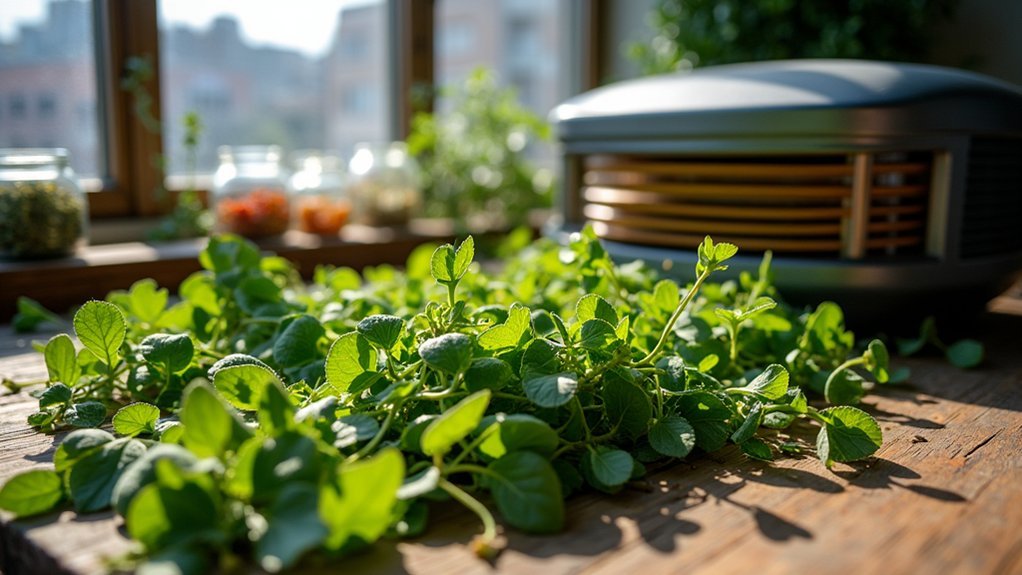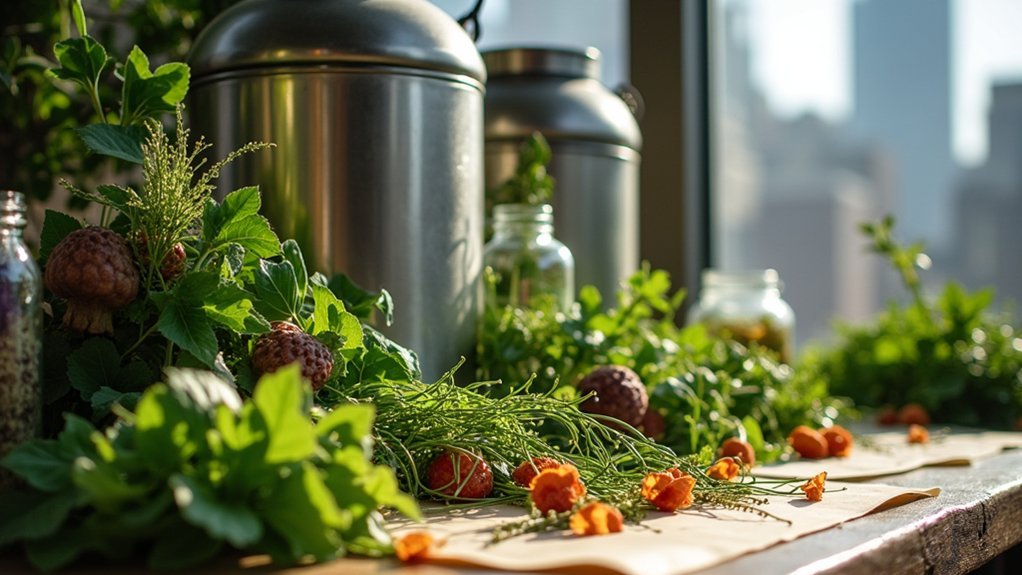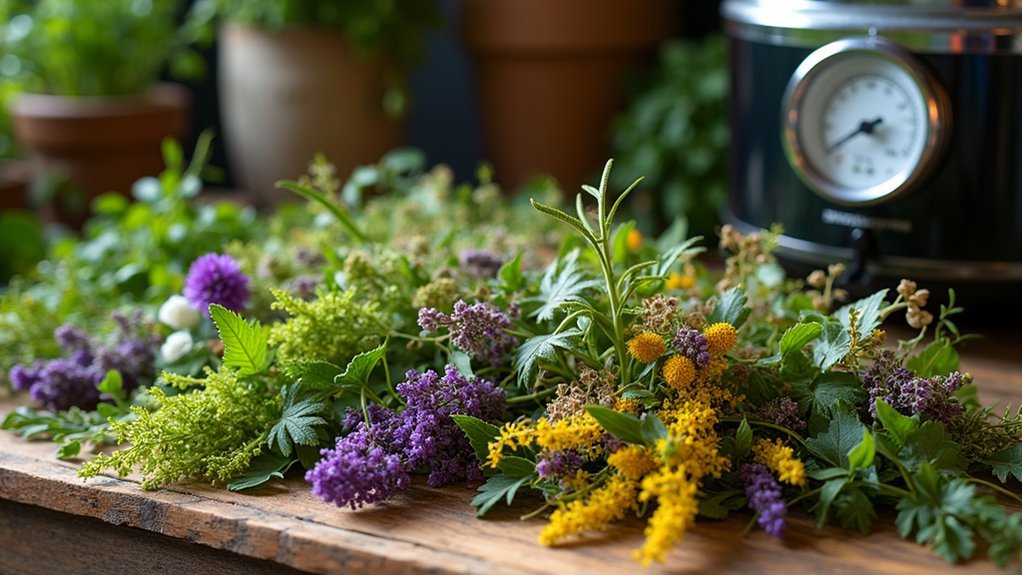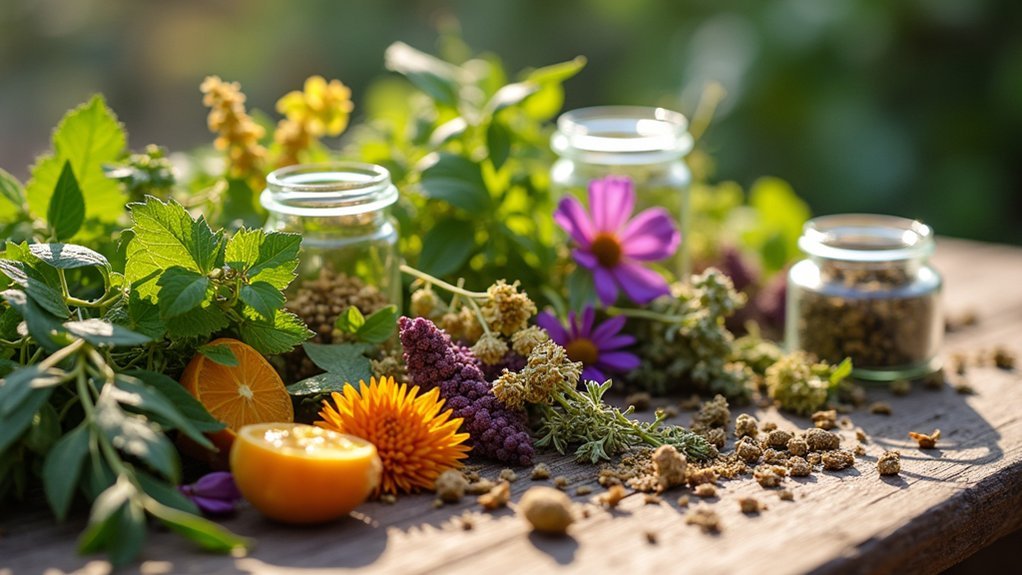Dehydrating wild city plants extends your foraging bounty year-round while preserving nutrients and flavors. Start by properly identifying safe plants, then clean thoroughly to remove contaminants. Use a food dehydrator at specific temperatures: herbs at 100°F, vegetables at 125-135°F, and fruits at 140°F. Store in airtight containers away from light and moisture. Follow the 10% harvesting rule to maintain plant populations. Discover how these preserved urban treasures can transform your cooking with unique, sustainable ingredients.
Ethical Urban Plant Harvesting Practices

While urban plants offer abundant resources for dehydration projects, harvesting them ethically requires careful consideration and responsibility. Before collecting any plant, verify it's properly identified to avoid toxic or endangered species. Misidentification could lead to serious health risks or ecological damage.
Use appropriate tools and techniques that minimize harm to plants and their surroundings, promoting sustainable regrowth. Follow the 10% rule—never take more than a tenth of any plant population you encounter. This leaves plenty for the plant to reproduce and for other foragers and wildlife.
Always check local regulations regarding urban foraging, as many areas restrict harvesting to protect native ecosystems.
Keep detailed records of your harvesting spots and dates to prevent overharvesting and to monitor plant population health over time.
Identifying Safe Plants in Urban Environments
How can you safely identify edible plants amid the concrete jungle? Urban environments harbor numerous wild edibles like dandelion greens and purslane, but proper identification is essential for your safety.
- Research thoroughly – Familiarize yourself with common edible plants in urban environments using reliable foraging guides and mobile identification apps with detailed images.
- Verify multiple characteristics – When identifying the plant, check leaves, stems, flowers, and growth patterns to distinguish edibles from toxic lookalikes.
- Assess surrounding conditions – Examine the area for potential contaminants like pesticides, polluted runoff, or proximity to busy roads.
- Join local expertise – Connect with experienced foragers through workshops or community groups to gain hands-on knowledge and validate your identifications before harvesting or dehydrating any urban wild edibles.
Essential Equipment for Plant Dehydration

Success in dehydrating urban foraged plants depends largely on having the right tools at your disposal. A food dehydrator with adjustable temperature settings is ideal for ensuring your plants become completely dry while preserving their essential qualities. If you don't have a dehydrator, your oven can substitute when set below 125°F, though you'll need to monitor closely to avoid cooking instead of drying fruits and leaves.
| Equipment | Purpose | Cost Range |
|---|---|---|
| Food Dehydrator | Precise temperature control | $40-200 |
| Dehydrator Trays | Maximizes drying space | $10-30 |
| Sharp Pruners | Clean harvesting cuts | $15-45 |
| Drying Screens | For air dry method | $5-20 |
| Airtight Containers | Long-term storage | $3-15 |
Sharp tools for harvesting and proper storage containers will greatly impact your final product's quality and shelf life.
Preparing Urban Plants for Preservation
Before you harvest urban plants, make sure you've correctly identified edible species using field guides or plant identification apps to avoid toxic lookalikes.
Prepare your plants by harvesting during dry weather after morning dew has evaporated, then rinse them thoroughly in cool water to remove dirt and urban pollutants.
Cut away damaged portions using sharp tools and lay out your cleaned specimens in a single layer on drying trays, ensuring proper spacing for efficient air circulation.
Plant Identification Guidelines
When venturing into urban landscapes for plant preservation, accurate identification becomes your critical first step in the dehydration process.
Before harvesting any plant material, you'll need resources that help you navigate the local flora confidently.
Equip yourself with these essential identification tools:
- Dichotomous keys and field guides – These references will guide you through specific plant characteristics for proper identification.
- Magnifying tools – Use these to examine minute details that distinguish similar species.
- Documentation supplies – Record date, location, and habitat to create thorough collection records.
- Community resources – Connect with herbaria and botanical societies for workshops that enhance your identification skills.
Don't rush this process—accurate plant identification guarantees both your safety and the scientific value of your preserved specimens.
Pre-Drying Preparation Steps
Once you've confidently identified your urban plant species, proper preparation becomes the foundation of successful dehydration. Harvest your plants in the morning after dew has evaporated, focusing on the top third for ideal flavor.
| Plant Type | Preparation | Drying Temperatures |
|---|---|---|
| Herbs/Leaves | Rinse with cold water, use salad spinner to remove excess moisture | 100°F |
| Fruits | Wash thoroughly, remove bruised portions, slice into 1/4-inch pieces | 140°F |
| Berries | Rinse gently, guarantee thoroughly dried before dehydrating | 140°F |
Before proceeding, verify all plant material is completely free of external moisture. Wet plants will steam rather than dry, compromising quality and extending dehydration time. Remember that proper cleaning removes urban contaminants while suitable drying temperatures preserve nutritional value and flavor.
Optimal Dehydration Methods and Temperatures

The dehydration technique you'll choose depends largely on your local climate conditions. In humid urban environments, electric dehydrators provide consistent results, while drier city climates might allow simple air-drying methods.
For ideal dried plant preservation, maintain proper temperatures:
- Fruits: Dehydrate at 140°F to maintain nutritional value while guaranteeing complete moisture removal.
- Vegetables: Process at 125-135°F, then store in glass jars after properly rehydrating for 1.5-2 hours in cold water.
- Herbs: Dry at lower temperatures (100°F) to preserve essential oils and aromas, harvesting before they bloom.
- Flowers and Seeds: Use gentle heat (115°F) to maintain color and viability.
Regardless of methods used, always arrange your urban harvests in single layers to guarantee proper airflow for consistent dehydration results.
Storage Solutions for Preserved Urban Plants
After mastering the art of dehydrating your urban plant harvests, proper storage becomes the next key focus.
Always place your dehydrated vegetables in airtight containers to prevent moisture absorption, which can quickly deteriorate quality. Store these containers in cool, dark locations to maximize shelf life—up to one year under ideal conditions.
Temperature control greatly impacts preservation duration; while dried fruits last about a year at 60°F, they'll only keep for six months at 80°F. For extended preservation, consider freezing your dehydrated vegetables in moisture-vapor-proof packaging.
Don't forget to rotate your preserved stock every six months, using the oldest items first. Regularly check for quality decline indicators like browning or flavor loss.
With proper storage techniques, you'll enjoy your urban harvest long after foraging season ends.
Creative Uses for Dehydrated Wild City Plants

Beyond simple preservation, dehydrated wild city plants offer a remarkable range of culinary and lifestyle applications you've likely never considered. Your urban foraging efforts can transform into gourmet ingredients that elevate everyday cooking.
- Craft personalized herbal teas by blending dried leaves and flowers from plants like mint, linden, or chamomile—each offering unique flavors and potential health benefits.
- Create signature seasoning blends using dehydrated herbs like wild thyme, oregano, or garlic mustard to enhance dishes with locally-sourced aromatics.
- Incorporate dried fruits and berries from urban plants into baked goods for natural sweetness and nutritional density.
- Experiment with infused oils by steeping dehydrated herbs in quality olive oil, creating distinctive bases for dressings, marinades, and finishing touches that showcase urban biodiversity.
Frequently Asked Questions
How Do You Dry Wild Plants?
You'll need to clean your wild plants thoroughly, then arrange them in a single layer on trays or hang in bundles. Dry them in a well-ventilated area away from direct sunlight for best preservation.
How Long Will Dehydrated Food Last?
Your dehydrated foods can last indefinitely in cool, dry, dark conditions. You'll get about a year for dried fruits at 60°F, six months at 80°F. Remember to rotate your stock as nutrients decline after one year.
How Long Does It Take to Dehydrate Plants?
You'll find dehydration times vary considerably: herbs typically take 1-4 hours at 100°F, fruits need 6-12 hours at 140°F, vegetables require 6-12 hours at 125°F, and denser plants may take up to 24 hours.
How Long Does Dehydrated Squash Last?
Your dehydrated squash will last 6-12 months when stored in airtight containers in a cool, dark place. You'll notice quality decline after a year, so it's best to rotate your stock every six months.
In Summary
You've now mastered the art of urban foraging and plant preservation. By following ethical harvesting practices and proper dehydration techniques, you'll enjoy nature's bounty year-round. Your collection of preserved city plants doesn't just connect you to urban ecosystems—it provides sustainable ingredients for cooking, crafting, and medicine. Start small, experiment often, and you'll transform overlooked sidewalk greenery into valuable botanical treasures.





Leave a Reply